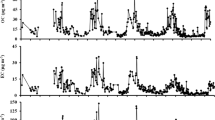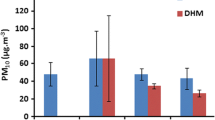Abstract
Carbonaceous Aerosols (CAs) have played an active role in the Earth's atmospheric system, climate, human health, and radiative forcing. Due to their significant role in the atmosphere, it was imperative to characterize the carbonaceous components [organic carbon (OC), elemental carbon (EC), water-soluble organic carbon (WSOC), and total carbonaceous aerosols (TCA)] of PM2.5 samples collected at three different urban locations (Mohal-Kullu, Almora, and Darjeeling) of the Himalayan region of India during August 2018–December 2019. The annual average mass concentrations of PM2.5 were recorded as 40 ± 27, 27 ± 21, and 38 ± 13 µg m−3 for Mohal-Kullu, Almora, and Darjeeling, respectively, which is near the Indian National Ambient Air Quality Standards (NAAQS) (24 h: 60 µg m-3; annual: 40 µg m−3). The OC/EC ratio and significant correlation of OC with EC and WSOC with OC indicated a substantial effect of biomass burning and secondary organic aerosol formation over the study sites. OC was found to be secondary in nature over the study sites during the study period. The contribution of TCA in PM2.5 showed CAs as a significant contributor to the mass concentration of particulate matter (PM) over the Himalayan regions. HYSPLIT model demonstrates that regionally transported air masses, mostly from Indo-Gangetic plain (IGP), the Thar desert, the semi-arid region, Nepal, and local areas, considerably influence PM concentrations and chemical composition over the pristine Himalayan altitudes. The study implies that to improve the air quality in booming urban areas, it is necessary to pay attention to both local emission sources and meteorological conditions.




Similar content being viewed by others
References
A. Chakraborty, S.K. Satheesh, R.S. Nanjundiah and J. Srinivasan, Impact of Absorbing Aerosols on the Simulation of Climate over the Indian Region in an Atmospheric General Circulation Model. Ann. Geophys., 22(5) (2004) 1421–1434. https://doi.org/10.5194/angeo-22-1421-2004.
A. Chakraborty, R.S. Nanjundiah and J. Srinivasan, Local and Remote Impacts of Direct Aerosol Forcing on Asian Monsoon. Int. J. Climatol., 34(6) (2014) 2108–2121. https://doi.org/10.1002/joc.3826.
S. Menon, J. Hansen, L. Nazarenko and Y. Luo, Climate Effects of Black Carbon Aerosols in China and India. Science, 297(5590) (2002) 2250–2253. https://doi.org/10.1126/science.1075159.
C.E. Chung, V. Ramanathan and J.T. Kiehl, Effects of the South Asian Absorbing Haze on the Northeast Monsoon and Surface-Air Heat Exchange. J. Clim., 15(17) (2002) 2462–2476. https://doi.org/10.1175/1520-0442(2002)015%3c2462:EOTSAA%3e2.0.CO;2.
V. Ramanathan, P.J. Crutzen, J.T. Kiehl and D. Rosenfeld, Aerosols, Climate, and the Hydrological Cycle. Science, 294(5549) (2001) 2119–2124. https://doi.org/10.1126/science.1064034.
C.L. Weagle, G. Snider, C. Li, A. Donkelaar, S. Philip, P. Bissonnette, J. Burke, J. Jackson, R. Latimer, E. Stone, I. Abboud, C. Akoshile, N.X. Anh, J.R. Brook, A. Cohen, J. Dong, M.D. Gibson, D. Griffith, K.B. He, B.N. Holben, R.V. Martin, Global Sources of Fine Particulate Matter: Interpretation of PM2.5 Chemical Composition Observed by SPARTAN using a Global Chemical Transport Model, Environ. Sci. Technol., 52 (2018) 11670–11681. https://doi.org/10.1021/acs.est.8b01658.
K. Ram, M.M. Sarin, R. Rengarajan and A.K. Sudheer, Carbonaceous and Secondary Inorganic Aerosols during Wintertime Fog and Haze over Urban Sites in the Indo-Gangetic Plain. Aerosol Air Qual. Res., 12 (2013) 359–370. https://doi.org/10.4209/aaqr.2011.07.0105.
H.-J. Lim and B.J. Turpin, Origins of Primary and Secondary Organic Aerosol in Atlanta: Results of Time-Resolved Measurements during the Atlanta Supersite Experiment. Environ. Sci. Technol., 36(21) (2002) 4489–4496. https://doi.org/10.1021/es0206487.
D. Ji, W. Gao, W. Maenhaut, J. He, Z. Wang, J. Li, W. Du, L. Wang, Y. Sun, J. Xin, B. Hu and Y. Wang, Impact of Air Pollution Control Measures and Regional Transport on Carbonaceous Aerosols in Fine Particulate Matter in Urban Beijing, China: Insights Gained from Long-Term Measurement. Atmospheric Chem. Phys., 19 (2019) 8569–8590. https://doi.org/10.5194/acp-19-8569-2019.
B. Hou, G. Zhuang, R. Zhang, T. Liu, Z. Guo and Y. Chen, The Implication of Carbonaceous Aerosol to the Formation of Haze: Revealed from the Characteristics and Sources of OC/EC over a Mega-City in China. J. Hazard. Mater., 190(1) (2011) 529–536. https://doi.org/10.1016/j.jhazmat.2011.03.072.
H. Ni, R.J. Huang, J. Cao, W. Liu, T. Zhang, M. Wang, H.A. Meijer and U. Dusek, Source apportionment of carbonaceous aerosols in Xi’an, China: insights from a full year of measurements of radiocarbon and the stable isotope 13 C. Atmos. Chem. Phys., 18(22) (2018) 16363–16383.
J. Zhang, L. Liu, Y. Wang, Y. Ren, X. Wang, Z. Shi, D. Zhang, H. Che, H. Zhao, Y. Liu and H. Niu, Chemical composition, source, and process of urban aerosols during winter haze formation in Northeast China. Environ. Pollut., 231 (2017) 357–366.
X. Wu, C. Chen, T.V. Vu, D. Liu, C. Baldo, X. Shen, Q. Zhang, K. Cen, M. Zheng, K. He and Z. Shi, Source apportionment of fine organic carbon (OC) using receptor modelling at a rural site of Beijing: Insight into se sonal and diurnal variation of source contributions. Environ. Pollut., 266 (2020) 115078E.
A.C. Diapouli, C. Kalogridis, S. Markantonaki, P. Vratolis, C. Fetfatzis, Colombi, and K. Eleftheriadis, Annual variability of black carbon concentrations originating from biomass and fossil fuel combustion for the suburban aerosol in Athens, Greece, Atmosphere, 8(12), 234 (2017).
H. Joshi, M. Naja, L.M. David, T. Gupta, M.M., Gogoi, S.S. Babu, Absorption Characteristics of Aerosols over the Central Himalayas and Its Adjacent Foothills. Atmospheric Res., 233, 104718 (2020). https://doi.org/10.1016/j.atmosres.2019.104718.11
E. Saikawa, A. Panday, S. Kang, R. Gautam, E. Zusman, Z.S.E.S. Cong, B. Adhikary, Air pollution in the hindu kush Himalaya. In: Wester P, Mishra A, Mukherji A, Shrestha AB (eds) The hindu kush Himalaya assessment—mountains, climate change, sustain ability and people, Springer Nature Switzerland AG, Cham, pp 339–387 (2019).
Y. Chen, S. Xie, B. Luo, Seasonal variations of transport path ways and potential sources of PM2.5 in Chengdu, China (2012– 2013). Front. Environ. Sci. Eng. 12(1):12 (2018).
S. Ghosh, J. Biswas, S. Guttikunda, S. Roychowdhury, M. Nayak, An investigation of potential regional and local source regions afecting fne particulate matter concentrate (2015).
S.K. Sharma, N. Choudhary, G. Kotnala, D. Das, S. Mukherjee, A. Ghosh, N. Vijayan, A. Rai, A. Chatterjee, and T.K. Mandal, Wintertime carbonaceous species and trace metals in PM2.5 in Darjeeling: a high-altitude town in the eastern Himalayas. Urban Clim. 34:100668 (2020).
A. Rai, S. Mukherjee, A. Chatterjee, N. Choudhary, G. Kotnala, T.K. Mandal, and S.K. Sharma, Seasonal variation of OC, EC, and WSOC of PM2.5 and Their CWT analysis over the Eastern Himalaya. Aerosol Sci. Technol. 4:26–40 (2020).
A. Chatterjee, S. Mukherjee, M. Dutta, A. Ghosh, S.K. Ghosh and A. Roy, High Rise in Carbonaceous Aerosols Under Very Low Anthropogenic Emission Over Eastern Himalaya, India: Impact of Lockdown for COVID-19 Outbreak. Atmos. Environ. 244 117947 (2021).
S.K. Sharma, S. Mukherjee, N. Choudhary, A. Rai, A. Ghosh, A. Chatterjee, N. Vijayan, and T.K. Mandal, Seasonal variation and sources of carbonaceous species and elements in PM2.5 and PM10 over the eastern Himalaya. Environ. Sci. Pollut. Res. (2021). https://doi.org/10.1007/s11356-021-14361-z.
R. Sheoran, U.C. Dumka, D. G. Kaskaoutis, G. Grivas, K. Ram, J. Prakash, R.K. Hooda, R.K. Tiwari and N. MihalopoulosL, Chemical Composition and Source Apportionment of Total Suspended Particulate in the Central Himalayan Region. Atmosphere, 12(9), (2021). https://doi.org/10.3390/atmos12091228.
D. Kaushal, A. Kumar, S. Yadav, A. Tandon and A. Attri, Wintertime Carbonaceous Aerosols Over Dhauladhar Region of North-Western Himalayas. Environ. Sci. Pollut. Res., 25 (2018) 1–13. https://doi.org/10.1007/s11356-017-1060-5.
C. Sarkar, A. Chatterjee, A.K. Singh, S.K. Ghosh, and S. Raha, Characterization of Black Carbon Aerosols Over Darjeeling-A High Altitude Himalayan Station in Eastern India, Aerosol Air Quality Res., 15(2) (2015) 465–478.
J.C. Kuniyal and R. Guleria, Aerosols Optical Properties Prone to Climate Change Over Mohal-Kullu in the Northwestern Himalaya, India. Conf. Indian Aerosol Sci. Technol. Assoc. Aerosols Clouds Clim. Change Perspect., 19(1) (2010) 227–230.
P. Hegde, K. Kawamura, H. Joshi, and M. Naja, Organic and inorganic components of aerosols over the central Himalayas: winter and summer variations in stable carbon and nitrogen isotopic composition, Environ. Sci. Pollut. Res. Int., 23 (2016). https://doi.org/10.1007/s11356-015-5530-3.
M. Naja, P. Bhardwaj, N. Singh, P. Kumar, R. Kumar, N. Ojha, R. Sagar, S.K. Satheesh, K.K. Moorthy and V.R. Kotamarthi, High-Frequency Vertical Profiling of Meteorological Parameters Using AMF1 Facility during RAWEX–GVAX at ARIES, Nainital. Curr. Sci., 111 (2016) 132–140.
R.R. Draxler, HYSPLIT4 user’s guide. NOAA Tech. Memo. ERL ARL-230, NOAA Air Resources Laboratory, Silver Spring, MD (1999).
L.M. Castro, C.A. Pio, R.M. Harrison and D.J.T. Smith, Carbonaceous Aerosol in Urban and Rural European Atmospheres: Estimation of Secondary Organic Carbon Concentrations. Atmos. Environ., 33(17) (1999) 2771–2781. https://doi.org/10.1016/S1352-2310(98)00331-8.
S. Mukherjee, M. Dutta, A. Ghosh, A. Chatterjee, A Year-Long Study on PM2.5 and Its Carbonaceous Components over Eastern Himalaya in India: Contributions of Local and Transported Fossil Fuel and Biomass Burning during Premonsoon. Environ. Res. 212:113546 (2022). https://doi.org/10.1016/j.envres.2022.113546.
P. Srivastava and M. Naja, Characteristics of Carbonaceous Aerosols Derived from Long-Term High-Resolution Measurements at a High-Altitude Site in the Central Himalayas: Radiative Forcing Estimates and Role of Meteorology and Biomass Burning. Environ. Sci. Pollut. Res., 28 (2021) 1–17. https://doi.org/10.1007/s11356-020-11579-1.
A. Kumar, S. Singh, N. Kumar, N. Singh, K. Kumar and S. Chourasiya, 845 Assessment of Carbonaceous Fractions in Ambient Aerosols at High Altitude and Lowland Urban 846 Locations of Kumaon Province, Indian Himalaya. SN Appl. Sci., 3(1) (2021) 1–14.
R. Rengarajan, M.M. Sarin and A.K. Sudheer, Carbonaceous and Inorganic Species in Atmospheric Aerosols During Wintertime Over Urban and High‐Altitude Sites in North India, J. Geophys. Res., 112 (2007). https://doi.org/10.1029/2006JD008150.
K. Ram, M.M. Sarin and P. Hegde, Atmospheric Abundances of Primary and Secondary Carbonaceous Species at Two High-Altitude Sites in India: Sources and Temporal Variability. Atmos. Environ., 42(28) (2008) 6785–6796.
K. Sandeep, R.S. Negi, A.S. Panicker, A.S. Gautam, D.S. Bhist, G. Beig, B.S. Murthy, R. Latha, S. Singh, and S. Das, Characteristics and variability of carbonaceous aerosols over a semi urban location in Garhwal Himalayas. Asia-Pacific J. Atmos. Sci. 56(3):455–465 (2020).
Acknowledgements
The authors (SKS, TKM, NC, AR) are thankful to Director, CSIR-NPL, New Delhi, for their encouragement and support for this study. The authors (SKS, TKM, and AR) acknowledged the Department of Science and Technology (DST), Government of India, New Delhi, India, for providing financial support for this study (DST/CCP/Aerosol/88/2017). One of the authors (NC) also acknowledges the DST, New Delhi, for providing the research fellowship. The authors (JCK, RL, SC, IT & AB) thank the Director, G.B. Pant, National Institute of Himalayan Environment (NIHE), for providing facilities. These authors (JCK, RL, SC, IT&AB) also acknowledge ISRO-SPL for providing partial funds to conduct the studies under Aerosol Radiative Forcing over India (ARFI). The authors thankfully acknowledge the NOAA Air Resources Laboratory for downloading the air mass trajectories (http://www.arl.noaa.gov/ready/hysplit4.html) datasets.
Author information
Authors and Affiliations
Corresponding authors
Additional information
Publisher's Note
Springer Nature remains neutral with regard to jurisdictional claims in published maps and institutional affiliations.
Rights and permissions
Springer Nature or its licensor (e.g. a society or other partner) holds exclusive rights to this article under a publishing agreement with the author(s) or other rightsholder(s); author self-archiving of the accepted manuscript version of this article is solely governed by the terms of such publishing agreement and applicable law.
About this article
Cite this article
Choudhary, N., Kuniyal, J.C., Lata, R. et al. Fine Mode Carbonaceous Aerosols of PM2.5 Over the High-Altitude Stations of the Indian Himalayas. MAPAN 38, 771–778 (2023). https://doi.org/10.1007/s12647-023-00647-9
Received:
Accepted:
Published:
Issue Date:
DOI: https://doi.org/10.1007/s12647-023-00647-9




